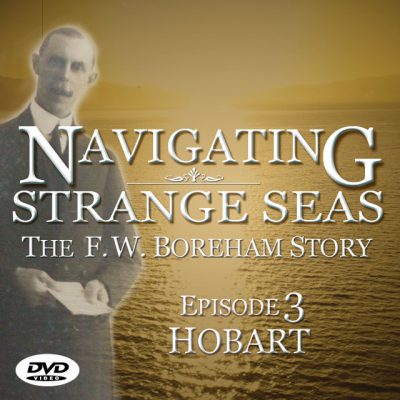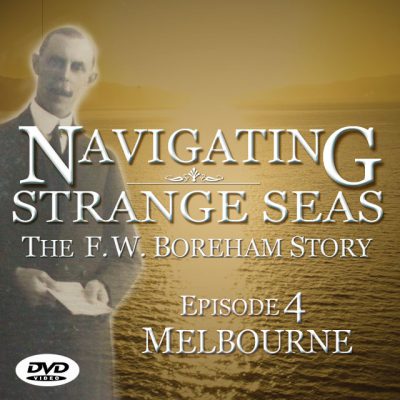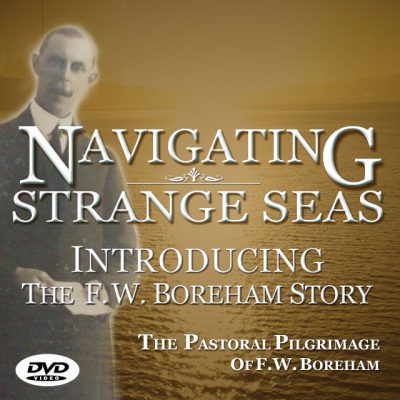
Originally published in AUSTRALIAN CHRISTIAN WORLD, April 14, 1944
THE IDEAL CONGREGATION
By Dr. F. W. BOREHAM
THERE may be some question as to which is the largest congregation in the world; there may be some doubt as to which is the richest : but there can be no uncertainty as to which is the best. The best congregation in the world is a congregation of one. And the best of that best congregation is that anyone can enjoy the privilege of addressing it.
Mr Chesterton says that, between one and two there is often a difference of millions. There is certainly a difference of millions between a congregation of one and a congregation of two. A congregation of one takes every word in a direct and personal and practical sense; but, in a congregation of two, each auditor takes it for granted that the preacher is referring to the other. Nathan had a congregation of one when he unfolded his parable on the one ewe lamb, and, looking into the face of David, cried Thou art the Man! By means of that clever artifice and lightning-flash application, Nathan brought his congregation of one to its knees.
Shakespeare must have studied this story of Nathan before writing his own Hamlet. Adopting Nathan’s strategy, Hamlet trained the strolling players to reproduce the king’s crime before the royal but guilty party ; and, when the monarch saw his own evil deeds enacted on the stage before him, the blood left his face, his heart stood still, the lights swam in blurred confusion before his failing sight, and, pleading sudden sickness, he staggered from the theatre. Every actor seemed to be pointing straight at him. Every voice cried: Thou art the man!
Just occasionally, of course, a preacher finds it easy to make his appeal to the individual conscience. Dr Lyman Beecher, for example, loved to tell of a memorable Sunday in the early days of his ministry. He had promised to exchange pulpits with a country preacher. When the day arrived, the hedgerows were buried in snow. His horse could scarcely plough its way through the deep drifts. When service-time came Dr. Beecher had the building all to himself. He was just about to remount and ride back when one solitary worshipper stole in. Now what ought he to do? After a brief consideration, he recalled the sense of guidance that he had experienced when preparing for the service. He thereupon decided to behave just as if the church were crowded. He did. Twenty years later a gentleman in Ohio, stepping up to Dr. Beecher, addressed him by name.
“Have we met before?” asked the doctor. “We have!” replied his companion. “Do you remember, twenty years ago, preaching to a single person?”
“I do indeed,” admitted Dr. Beecher, grasping his hand, “and, if you are the man, I want you to know that I have been looking for you ever since!”
“I am the man, sir; and that sermon, leading me to the Saviour, made a minister of me. Yonder is my church! The converts of that sermon are all over Ohio!”
The task of reaching the individual ear and the individual conscience is not always as simple a matter as on that notable occasion, Dr. Beecher found it.
I.
Here, for example, is a preacher who, deeply conscious of the unutterable value of the individual soul, finds himself called to preach to hundreds, perhaps thousands of people. His situation appears hopeless. A crowd is a bewilderment and an embarrassment unless the preacher knows how to take it to pieces. A lawyer cannot deal with clients in crowds; a doctor cannot deal with patients in crowds; and, faced by a crowd, an evangelist is just as helpless. The preacher who has to face a crowd must be a skilful psychologist as well as an earnest evangelist. A crowd has no conscience to be stirred, no heart to be broken, and no soul to be saved. The man who stands before the crowd can only hope to succeed so far as he knows how to disentangle the individual from the mass. Like a stockman who, riding into a mob of cattle swiftly and cleverly separates from its fellows the animal that he requires, the preacher must know how, with consummate skill and infinite tact, to segregate and capture the individual. Wesley and Whitefield, Spurgeon and Moody knew how to preach to crowds. They conquered the crowd by ignoring it. So far from forgetting the individual in the crowd, they forgot the crowd in the individual. They liked to see a multitude of faces, just as an angler likes to feel that his line is surrounded by a multitude of fish; it enhances his chance of catching, in quick succession, first one and then another; but that is as far as it goes. To the skilful evangelist the crowd is simply the multiplied opportunity of individual conquest.
Jean Baptiste Massillon, the man whose preaching terrified yet magnetised Louis The Fourteenth, had an oratorical trick by means of which, even in a thronged cathedral, he secured for himself not one congregation of two thousand, but two thousand congregations of one.
“The dome has vanished,” he would exclaim dramatically, “the ceiling has disappeared; nothing now intervenes between you and Almighty God! And see, the walls have evaporated and the great congregation has dispersed; you and I are left alone together! Just you and I!” And then, like a skilful surgeon alone with his patient, he would probe to the very depths of his hearer’s secret being. Louis the Magnificent used to say that he enjoyed hearing other preachers; he never enjoyed Massillon, for Massillon seemed to tear his very soul wide open; yet, if he had to select one preacher and hear him only, he would wish that one preacher to be Massillon.
But let me cite a couple of more familiar, yet strangely contracting cases. Massillon died at just about the time of John Wesley’s conversion. Now what was the secret of Mr Wesley’s amazing influence on English history? No body who has read his sermons can seriously attribute it to anything that he actually said. His utterances were excellent but by no means sublime. If, however, any man possessed the stockman’s art of segregating the individual from the mass, Mr. Wesley was that man. By a master stroke a spiritual statesmanship, Mr. Wesley impressed upon his converts the desirability of committing to paper the story of his new birth. As a consequence, we still treasure an immense sheaf of these priceless records. They are most fascinating documents, and, though they differ in glory like the stars, yet, in one important respect, they are all alike. For they all contain some such such phrase as this: “Mr. Wesley seemed to be speaking directly to me as though I were the only person present!” Wesley’s words, Southey says, “were like the eyes of a portrait, they seemed to face each beholder.” “Who,” Mr. Wesley seemed to Southey to be always saying, “who are thou? Thou are the man! I want they for my Lord! I challenge thee! The Lord hath need of thee! O come quickly! Believe on the Lord Jesus Christ and thou, even thou, art reconciled to God!”
One of the greatest days in Wesley’s life was June 17, 1739. It was the day on which he preached for the first time at Moorfields. The service was held at seven o’clock in the morning, and there were seven thousand people present. Mr. Wesley took for his text the words: “Seek ye the Lord while He may be found; call ye upon Him while He is near. Let the wicked forsake his was and the unrighteous man his thoughts, and let him return unto the Lord and He will have mercy upon him, and to our God, for He will abundantly pardon.” The service was made doubly historic; for, in the first place, it was the beginning of the great work at Moorfields, and, in the second, it led to the conversion of John Nelson, the stonemason, “a man who,” as Southey says, “had as high a spirit and as brave a heart as ever Englishman was blessed with.”
A little later, on the same day, Mr. Wesley preached to an immense concourse at Kennington on the same text, and, among others, a soldier was converted. I have found it extremely interesting to piece together, and examine in detail, the records of those memorable services. Fortunately, both the stonemason and the soldier have reduced to writing the story of their experiences.
“O that was a blessed morning to my soul,” writes John Nelson. “As soon as Mr. Wesley stood up and stroked back his hair, he fixed his eyes on me. It made my heart beat like the pendulum of a clock; and, when he began to speak, I thought his whole discourse was aimed directly at me!”
“When Mr. Wesley began to speak,” says the soldier, “his words made me tremble. I thought he spoke to no one but me; and I durst not look up, for I imagined that all the people were looking at me!”
On each occasion there were thousands present, yet Mr. Wesley made each hearer feel that preacher and listener were alone together. Every man felt as David felt when Nathan pointed directly at him and cried Thou are the man! Every man felt as Louis the Fourteenth felt when listening to Massillon. It is the topmost pinnacle of the preachers’s art.
II.
My second illustration is a very different one. The setting is different; the atmosphere is different; the method is different; but the principle is the same. It is the conquest of the multitude by the capture of the individual; and the central figure, in this case, is Dr. George Augustus Selwyn, the pioneer Bishop of New Zealand.
Dr. Selwyn was a young fellow of thirty when he was appointed to his distant see. In drawing up the Letter Patent for his antipodean episcopate, the Crown solicitors made an astounding and egregious blunder. Although Selwyn noticed it, he whispered not a word. The area under the new bishop’s authority should have been defined as lying between latitude 34 south and latitude 50 south. But, by an incredible slip, it was actually defined as including all territories between latitude 34 north and latitude 50 south! Selwyn chuckled to himself, for he saw that this definition would make him Bishop of the entire Pacific and would afford him the opportunity of visiting and evangelising all the scattered islands of that immense ocean!
Later on, during a period of disturbance and turmoil in New Zealand, in which his work was brought practically to a standstill, he determined to avail himself of the privileges conferred upon him by the clerical error. He would attempt the evangelisation of all the coral reefs and cannibal islands of the tropical seas! He recognised, of course, that it would be absurd for him to undertake missionary work, in the ordinary sense, among these countless groups. It would take years to acquire the languages, understand the customs, and overcome the prejudices of the islanders. He determined to resort to strategy. The individual must become the key to the situation. He took a boy from this island and a boy from that one; he persuaded them to accompany him to New Zealand; and then he bent all his energies to winning them for Christ. Afterwards he returned each of these converts to his native island to evangelise his own people. In this way the Pacific was soon dotted with active evangelistic agencies, and the colourful archipelagoes of the south seas soon heard, from men of their own blood and language, the words of life eternal.
The case of Selwyn differs from the cases of Massillon and Wesley as sharply as those two differ from each other. But, like them, it demonstrates conclusively that the individual soul is the fundamental unit in universal conquest.
III.
But why should I have troubled my head with Massillon or Wesley or Selwyn? The supreme example is neither of these. In his exquisite little Life of Jesus Christ, Dr. Stalker shows that Jesus ever kept His divine eyes wide open for any opportunity of preaching to that best of all congregations, a congregation of one. He seized any such chance with avidity, Dr. Stalker declares. “Although He was worn out with fatigue, He talked to the woman at the well; He chatted with Zacchaeus under the sycamore tree; He received Nicodemus alone at night; He taught Mary in the home at Bethany. Brief as the gospels are, they contain nineteen records of such personal interviews.” As an evangelist, as in every other respect, He is the model.
In his Alice-for-Short, Mr. William Frend de Morgan tells the story of little Mrs. Verrinder. Hers was a case of traumatic insanity. As the result of a fall, whilst still a young woman, the clock of her consciousness stops. She continues through the years to regard herself as a girl. She is confined in a mental hospital and in many respects enjoys excellent health. But her mind stands still. For sixty years she is dead to all the changing world about her. For thirty years her husband lived close to the asylum in order that he might be available if a lucid interval occurred. But none came, and, growing tired of waiting, he dropped into his grave. At length, with the advance of science, it is suggested that an operation might meet the case; and the work of skilful surgeons is crowned with complete success. Mrs Verrinder recovers; but, in recovering, has lost all sense of the years that the long illness has stolen from her. She fancies that she is still girlish and pretty. Alice-for-Short undertakes the delicate task of introducing her to herself. She leads her gently towards a full-length mirror.
“Who is that?” the old lady asks.
“Who is what?” Alice replies.
The old lady’s eyes search the room. “It’s very strange,” she says; “I could have sworn that I saw the reflection of a new old lady, with white hair, in the glass. Where is she?” She again looks round the room.
“There is no one here but ourselves,” says Alice.
“How very odd!” Mrs. Verrinder replies. “I could have sworn it.” And then she approaches nearer to the mirror; but, engaged in arranging the sleeves of her dress, she does not look up till she gets quite close. Then she breaks into a loud, hysterical laugh, more dreadful than any cry of pain.
“Oh Alice,” she cries, “it’s me, it’s me, it’s me!”
She trembles like an aspen-leaf. Alice-for-Short guides her to a chair, bends over her, and kisses the wrinkled, upturned face. Mrs. Verrinder has made her great discovery. She had recognised herself!
“It’s me!” she cries, gazing into the mirror. When little Mrs Verrinder, gazing into the mirror, cried “It’s me! It’s me!” the restoration of her mind was complete. And when my congregation of one, hearing me speak of the man for whom the Saviour died, cries “It’s me! It’s me!” there is joy in the presence of the angels over that happy man’s salvation.






